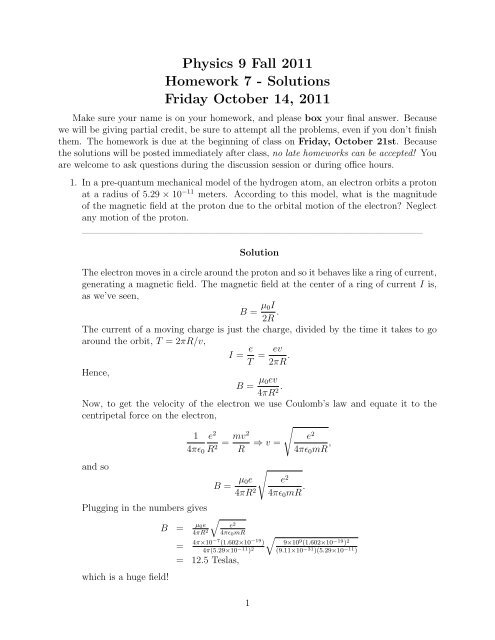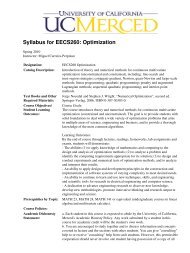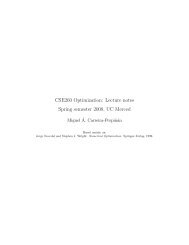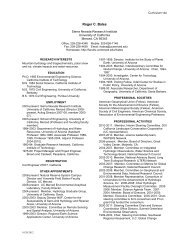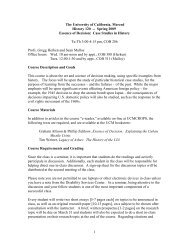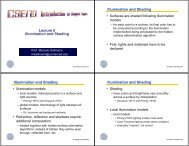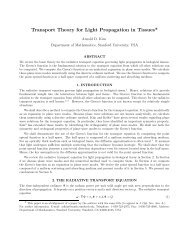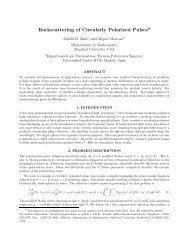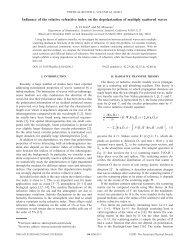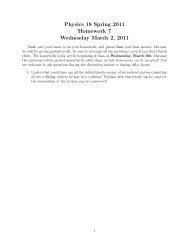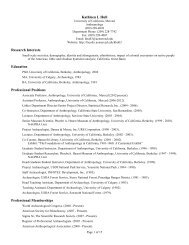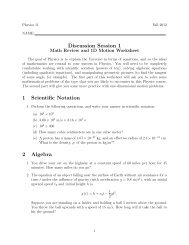Physics 9 Fall 2011 Homework 7 - Solutions Friday October 14, 2011
Physics 9 Fall 2011 Homework 7 - Solutions Friday October 14, 2011
Physics 9 Fall 2011 Homework 7 - Solutions Friday October 14, 2011
You also want an ePaper? Increase the reach of your titles
YUMPU automatically turns print PDFs into web optimized ePapers that Google loves.
<strong>Physics</strong> 9 <strong>Fall</strong> <strong>2011</strong><br />
<strong>Homework</strong> 7 - <strong>Solutions</strong><br />
<strong>Friday</strong> <strong>October</strong> <strong>14</strong>, <strong>2011</strong><br />
Make sure your name is on your homework, and please box your final answer. Because<br />
we will be giving partial credit, be sure to attempt all the problems, even if you don’t finish<br />
them. The homework is due at the beginning of class on <strong>Friday</strong>, <strong>October</strong> 21st. Because<br />
the solutions will be posted immediately after class, no late homeworks can be accepted! You<br />
are welcome to ask questions during the discussion session or during office hours.<br />
1. In a pre-quantum mechanical model of the hydrogen atom, an electron orbits a proton<br />
at a radius of 5.29 × 10 −11 meters. According to this model, what is the magnitude<br />
of the magnetic field at the proton due to the orbital motion of the electron? Neglect<br />
any motion of the proton.<br />
————————————————————————————————————<br />
Solution<br />
The electron moves in a circle around the proton and so it behaves like a ring of current,<br />
generating a magnetic field. The magnetic field at the center of a ring of current I is,<br />
as we’ve seen,<br />
B = µ0I<br />
2R .<br />
The current of a moving charge is just the charge, divided by the time it takes to go<br />
around the orbit, T = 2πR/v,<br />
I = e<br />
T<br />
= ev<br />
2πR .<br />
Hence,<br />
B = µ0ev<br />
.<br />
4πR2 Now, to get the velocity of the electron we use Coulomb’s law and equate it to the<br />
centripetal force on the electron,<br />
1 e<br />
4πɛ0<br />
2<br />
<br />
mv2<br />
e<br />
= ⇒ v =<br />
R2 R 2<br />
4πɛ0mR ,<br />
and so<br />
Plugging in the numbers gives<br />
which is a huge field!<br />
B = µ0e<br />
4πR 2<br />
B = µ0e<br />
4πR2 <br />
e2 4πɛ0mR .<br />
e 2<br />
4πɛ0mR<br />
= 4π×10−7 (1.602×10 −19 )<br />
4π(5.29×10 −11 ) 2<br />
= 12.5 Teslas,<br />
1<br />
9×10 9 (1.602×10 −19 ) 2<br />
(9.11×10 −31 )(5.29×10 −11 )
2. A particle of mass m and charge q enters a region where there is a uniform magnetic<br />
field B parallel with the x axis. The initial velocity of the particle is v = v0xî + v0yˆj, so the particle moves in a helix.<br />
(a) Show that the radius of the helix is r = mv0y<br />
qB .<br />
(b) Show that the particle takes a time ∆t = 2πm<br />
qB<br />
to complete each turn of the helix.<br />
(c) What is the x component of the displacement of the particle during the time given<br />
in part (b)?<br />
————————————————————————————————————<br />
Solution<br />
(a) The magnetic force on a charge, q, moving at a speed v through a magnetic field<br />
B is given by the Lorentz force law,<br />
F = qv × B.<br />
Now, the magnetic field is along the î axis, so we can write B = Bî, and so<br />
<br />
F = q î + v0yˆj × Bî = −qv0yB ˆ k,<br />
v0x<br />
where we have recalled that î × î = 0, and ˆj × î = − ˆ k. Thus, there is a net force<br />
on the charge in the negative z direction, pushing it downwards. This net force<br />
causes it to move in a circle in the yz plane at a speed v0y that drifts along the<br />
x direction at a speed v0x (i.e., it moves in a helix). The centripetal force is just<br />
equal to the magnetic force,<br />
Fmag = qv0yB = mv2 0y<br />
r<br />
Solving this expression for the radius gives<br />
r = mv0y<br />
qB .<br />
= Fcent.<br />
(b) The time to complete one turn of the helix is just the time it takes to go around<br />
a circle of radius r, which is<br />
∆t = 2πr<br />
v0y<br />
= 2πmvoy<br />
v0yqB<br />
= 2πm<br />
qB .<br />
(c) During the time, ∆t, it takes for the particle to make a circle it moves a distance<br />
∆x = v0x∆t along the x direction. This distance is<br />
∆x = v0x∆t = 2πmv0x<br />
qB .<br />
2
3. The closed loop shown in the figure to the right<br />
carries a current of 8.0 A in the counterclockwise<br />
direction. The radius of the outer arc is 0.60 m<br />
and that of the inner arc is 0.40 m. Find the<br />
magnetic field (magnitude and direction) at point<br />
P .<br />
————————————————————————————————————<br />
Solution<br />
By the right-hand rule for currents, the magnetic field from the top of the circuit points<br />
out of the page, while that from the bottom of the circuit points into the page. Since<br />
both branches carry the same current, and since the bottom branch is closer, it wins<br />
out and the magnetic field points into the page.<br />
The total magnetic field is just the sum of the two semicircles (the straight-line segments<br />
contribute nothing, since they are inline with the point P). We can use the<br />
Biot-Savart law to determine the magnetic field from each semicircle. From the top,<br />
since the distance from the wire to the point is constant, r = R1, and the current is<br />
always tangent to the point, the Biot-Savart law says<br />
Btop = µ0I<br />
4π<br />
= µ0I<br />
4πR 2 1<br />
= µ0I<br />
4πR 2 1<br />
= µ0I<br />
12R1 ,<br />
<br />
ds׈r<br />
r2 <br />
ds<br />
where we have recalled that the distance around the semicircle is s = θR, and θ = π/3<br />
for a 60◦ angle. The magnetic field from the bottom wire is done in exactly the same<br />
way, but now the radius is only r = R2. So, Bbottom = − µ0I<br />
, where the minus sign<br />
12R2<br />
accounts for the direction of the field from the bottom branch (into the page).<br />
R1θ<br />
Combining the two fields gives the total,<br />
B = µ0I<br />
<br />
1<br />
−<br />
12 R1<br />
1<br />
<br />
= −<br />
R2<br />
µ0I<br />
(R1 − R2) .<br />
12R1R2<br />
4. Plugging in the numbers gives<br />
B = − µ0I<br />
(R1 − R2) = −<br />
12R1R2<br />
4π × 10−7 × 8<br />
(.6 − .4) = −7.0 × 10<br />
12(.6 × .4)<br />
−7 T,<br />
or about 0.7 µT, into the page.<br />
3
5. A long cylindrical shell has an inner radius a and an outer radius b and carries current<br />
I parallel to the central axis. Assume that within the material of the shell the current<br />
density is uniformly distributed. Find an expression for the magnitude of the magnetic<br />
field for<br />
(a) 0 < r < a,<br />
(b) a < r < b, and<br />
(c) r > b.<br />
————————————————————————————————————<br />
Solution<br />
We can determine the magnetic field using Ampere’s law, which says that<br />
<br />
B · ds = µ0Ithrough,<br />
where Ithrough is the current passing through the Amperian loop.<br />
(a) Inside the inner radius, (i.e., for r < a), there is no current inside this region, and<br />
so there is no magnetic field.<br />
(b) Inside the shell, itself (where a < r < b), then the current is uniformly distributed,<br />
such that the current density J is constant. Now, since the total current through<br />
the full area A = π (b 2 − a 2 ) is I, then the current density is<br />
J =<br />
I<br />
(b 2 − a 2 ) .<br />
Now, if we take our Amperian loop to be a circle of radius r, where a < r < b,<br />
then the current passing through this loops is<br />
Ithrough = JAthrough =<br />
I<br />
(b2 − a2 2 2<br />
r − a<br />
)<br />
.<br />
Notice that if r = a, then the total current is zero, as we should expect. Furthermore,<br />
if the loop encloses the entire shell (such that r = b), then the total current<br />
is I. Thus, we have the correct Ithrough.<br />
Now, the magnetic field is constant around our Amperian loop, so<br />
<br />
<br />
<br />
2 2<br />
B<br />
r − a<br />
· ds = B ds = (2πr) B = µ0I<br />
,<br />
and so the magnetic field is,<br />
B = µ0I<br />
2πr<br />
r 2 − a 2<br />
b 2 − a 2<br />
<br />
.<br />
b 2 − a 2<br />
Notice that, if r = a, then B = 0, and so we get the correct continuity of the<br />
magnetic field at the inner boundary.<br />
4
(c) Finally, if we are outside the shell (when r > b), then an Amperian loop contains<br />
the entire current, and so we just get back the field of a long straight current, or<br />
B = µ0I<br />
2πr .<br />
Again, notice that this result agrees with our answer from part (b) when r = b,<br />
again yielding the correct continuity of the field at the boundary.<br />
5
6. A nonconducting disk has radius R, carries a uniform surface charge density σ, and<br />
rotates with angular speed ω.<br />
(a) Consider an annular strip that has a radius r, a width dr, and a charge dq. Show<br />
that the current, dI, produced by this rotating strip is given by ωσrdr<br />
(b) Use your result from part (a) to show that the magnetic field strength at the<br />
center of the disk is given by the expression 1<br />
2 µ0σωR.<br />
(c) Use your result from part (a) to find and expression for the magnetic field strength<br />
at a point on the central axis of the disk a distance z from its center.<br />
————————————————————————————————————<br />
Solution<br />
(a) We can imagine that the strip has a radius r and thickness dr. If the surface<br />
charge density is σ, then the ring contains a small charge dq which is the area<br />
enclosed in the ring, times the surface charge density. Now, the ring has an area<br />
dA = 2πrdr, since the length of a ring of radius r is 2πr. So, dq = 2πrσdr. The<br />
current is dI = dq<br />
, where dt is the time it takes for the ring to go around in an<br />
dt<br />
orbit. So, in terms of the orbital frequency dt = 1/f, and since 2πf = ω, we have<br />
dI = dq<br />
dt<br />
= fdq = (2πf) rσdr = ωσrdr.<br />
(b) Now, as we’ve seen, the magnetic field at a distance z away from a ring of radius<br />
r and current dI is<br />
dB = µ0<br />
4π<br />
2πr2dI Plugging in for dI gives<br />
dB = µ0ωσ<br />
2<br />
(z2 + r2 . 3/2<br />
)<br />
r 3 dr<br />
(z2 + r2 . 3/2<br />
)<br />
Now, integrating this result from r = 0 to r = R gives<br />
B(z) = µ0ωσ<br />
2<br />
= µ0ωσ<br />
2<br />
= µ0ωσ<br />
2<br />
R<br />
0<br />
r3dr (z2 +r2 ) 3/2<br />
r2 +2z2 <br />
√ <br />
r2 +z2 R<br />
0<br />
R2 +2z2 √<br />
R2 +z2 − 2z<br />
This is actually the magnetic field at a distance z away from the center, and so<br />
we’ve done part (c), already. To find the field at the center, we simply set z = 0<br />
in our above expression,<br />
as claimed.<br />
B(0) = µ0ωσ<br />
2<br />
<br />
.<br />
<br />
2 2 R + 0<br />
√ − 0 =<br />
R2 + 02 1<br />
2 µ0σωR,<br />
6


